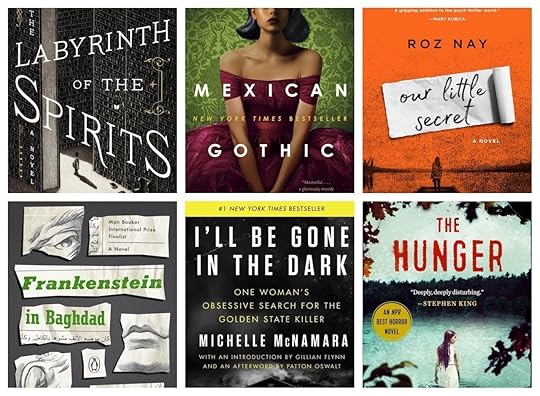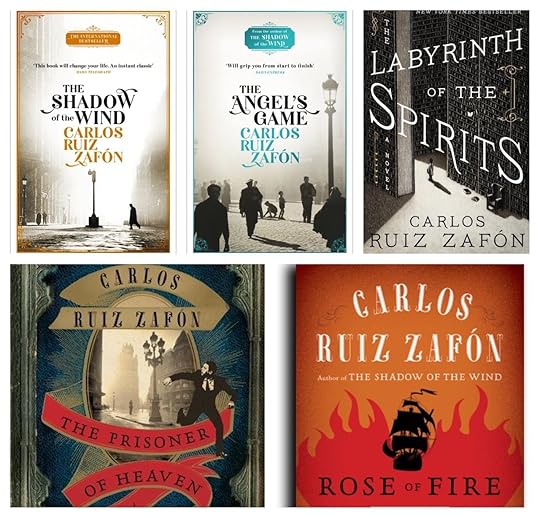Matador Network's Blog, page 770
October 7, 2020
New United Airlines destinations

Although the US airline industry has taken a major hit recently, being forced to dramatically reduce flight routes both domestically and abroad, they are slowly ramping up their service to meet with growing demand. United Airlines recently announced it would be adding 32 new routes to its network in November to a variety of warm-weather locations, just in time for Americans to escape the cold weather.
The route expansion includes 16 routes connecting Boston, Cleveland, Washington, and New York with Fort Lauderdale, Fort Myers, Orlando, Tampa, and Key West, as well as opening up and expanding 26 routes throughout Latin America and the Caribbean, like Santiago, Rio de Janeiro, Antigua, Curacao, Grand Cayman, Managua, Nassau, St. Lucia, Roatan, Acapulco, Cancun, Cozumel, Zihautanejo, Cabo San Lucas, and Puerto Vallarta.
Patrick Quayle, United’s vice president of international network and alliances, said in a press release, “For the month of November, we have adjusted our capacity to add flying for leisure travel to warm weather and beach destinations in Florida, Mexico and the Caribbean, along with ‘visiting friends and relatives’ travel across the globe.”
Despite the new additions, United will still be flying at just 44 percent of its usual schedule when compared to last year. 
More like thisCOVID-19Everything Americans need to know about traveling to Mexico right now
The post United is adding 32 warm-weather destinations to its network this fall appeared first on Matador Network.

Qatar Airways flights for teachers

There’s no doubt that teachers are underappreciated — especially in the midst of a pandemic — but Qatar Airways is trying to show its gratitude. In honor of World Teacher’s Day on October 5, the airline launched a promotion giving away 21,000 round-trip tickets to teachers around the world.
The initiative began on October 5 and ends on October 8 at 9 PM EST. Winners will receive a round-trip economy-class ticket to any of Qatar Airways’ 90 destinations worldwide. They will also receive a voucher for 50 percent off one future round-trip ticket that they can use for themselves or a loved one, valid through September 30, 2021.
To enter, teachers must submit a form on the promotion website, which includes some basic information like their school name and teacher ID number. The promotion is only valid for individuals living in countries where Qatar Airways operates, and winners will be expected to pay the airport taxes. Tickets are also valid for two years with unlimited change dates.
Akbar Al Baker, Chief Executive for Qatar Airways, said in a press release, “We at Qatar Airways are incredibly grateful for the commitment and hard work of teaching professionals around the world who continue to educate our young people in these times of uncertainty. We know that it has not been an easy task, yet teachers have been incredibly resourceful, turning to online learning and other methods.” 
More like thisAirports + FlyingTwo new services help travelers get into the Global Entry program faster
The post Qatar Airways is giving away 21,000 free return flights to teachers appeared first on Matador Network.

October 6, 2020
Best scary books to read this fall

While horror flicks are a surefire way to get you to look under the bed before switching off your nightlight, there’s a more subtle, long-drawn way to give you the creeps this Halloween. Beyond the famous works of Stephen King, literature is rife with sinister tales that can compete with the most hair-raising movies out there, and because it’s not easy to read an entire book over the course of one night, a scary one can keep you on tenterhooks for many days. Whether that’s fantastical tales of pacts with the devil or true crime stories, the following reads will have you check your locks and windows carefully until at least next spring.
1. The Cemetery of Forgotten Books series by Carlos Ruiz Zafón

Photo: Harper Collins + Harper Collins + Carlos Ruiz Zafón
The Cemetery of Forgotten Books, a series composed of, surprisingly, four and a half works of fiction, is is not recent — the first volume, The Shadow of the Wind was published in English in 2004, and the last, The Labyrinth of the Spirits was released in 2018. But this fall is a great time to dive into it — if only just to honor the Spanish author, Carlos Ruiz Zafón, who sadly passed away earlier this summer.
The four novels and one short story that comprise the series are all set in old Barcelona, and it’s nothing like today’s tourist destination — it’s dark, violent, and full of untrustworthy characters, some of whom are working for cruel dictator Franco or are the devil incarnate, depending on what volume you pick up. All four and a half books are thrillers interwoven through their gothic genre (think labyrinthine and imposing castle-like structures, fog, and supernatural events); through the books read, loved, or written by the characters; through the characters themselves (the Sempere family is featured in every book); and through the eponymous Cemetery of Forgotten Books, a secret and obscure library located in the heart of the city.
You can read the quadrology in the order of publication or in the chronological order of the story, but for comprehension’s sake, don’t leave too much time in between each of them or you won’t remember who is the son of whom and who did what. And you don’t want to be frustrated when reading this series — what you want is to be comfortable and ready to bite your nails down to nothing because there’s only one way through those books, and it’s the mysterious and creepy way.
The Shadow of the Wind, set in 1945, published in English 2004
The Angel’s Game, set in the 1920s, published in English in 2009
Rose of Fire, set in the 15th century, published in English in 2012 (short story)
The Prisoner of Heaven, set in 1957, published in English in 2012
The Labyrinth of the Spirits, set in 1958, published in English in 2018
2. I’ll Be Gone in the Dark: One Woman’s Obsessive Search for the Golden State Killer by Michelle McNamara

Photo: I’ll Be Gone in the Dark
True crime novels are always more disturbing than crime fiction, but few are as unsettling as McNamara’s account of the numerous grisly crimes committed by one seemingly psychopathic man over the course of a decade in California.
Between 1976 and 1986, one man, whom McNamara has nicknamed the Golden State Killer, terrorized parts of California by committing over 50 sexual assaults and at least 10 murders. He would stalk suburban houses and visit them before his attacks to make sure a window or door would be unlocked so he could slip in under the cover of night and proceed to destroy people’s lives forever.
McNamara, who passed away in 2016 before finishing this book, was obsessed with finding the man who had evaded capture for over 40 years, and it shows in the incredible level of details in her research and the countless hours of work she put in interviewing people, accessing old files, etc. The book was finished thanks to McNamara’s lead researcher and a colleague. It was published in February 2018, just two months before James Deangelo, the perpetrator, was found thanks to genetic genealogy and arrested. In the summer of 2020, he pleaded guilty to 13 counts of first-degree murder.
Knowing that the Golden State Killer is finally behind bars does not make McNamara’s book less frightening — it gives readers a chilling and scrupulously specific report of Deangelo’s horrific crimes — but at least you can go to sleep with the knowledge that he can’t do any more harm. The book, and McNamara’s story, was also recently into an HBO docuseries.
3. Frankenstein in Baghdad by Ahmed Saadaw

Photo: Penguin Random House
It’s hard to imagine a novelist improving on a scary story with the staying power of Mary Shelley’s Frankenstein. Shelley’s novel, published in 1818, is often called the world’s first science fiction novel, though fans of the horror genre are more inclined to identify the campfire tale turned literary classic as a giant in the world of gothic literature. In 2013, Iraqi author Ahmed Saadaw took on the challenge of recontextualizing Shelley’s Frankenstein for a modern audience, capitalizing on the all-too-real horrors of the Iraq War for his novel’s setting.
In Saadaw’s retelling, a junk dealer named Hadi reanimates a monster known as Whatitsname whom he stitched together using body parts that were dismembered by explosives. Yet even before Whatitsname is brought to life, and develops a taste for vengeance on behalf of the city’s bombing victims, the Baghdadis central to the novel are plagued by the fear of man-on-man violence. Saadaw artfully approaches the story with a matter-of-fact, and at times even humorous, tone that exposes the absurdity and chaos of modern warfare.
By blending supernatural themes borrowed from Shelley’s Frankenstein with real-world themes most readers have not had to personally confront, Saadaw weaves together a complex narrative that leaves you unsettled in ways most works of horror and science fiction only aspire to.
4. The Hunger by Alma Katsu

Photo: Penguin Random House
Truth, as they say, is stranger than fiction. The same principle applies to horror stories: They’re that much more terrifying when rooted in real events. Alma Katsu’s award-winning novel The Hunger tells the infamous story of the Donner Party, a band of California-bound, 19th-century emigrants that resorted to cannibalism after getting trapped in the Sierra Nevada mountains. The true events of the harrowing westward journey are difficult enough to stomach, but Katsu does not stop at the grim historical details: Her novel also introduces a dose of the supernatural.
Ironically, Katsu downplays the cannibalistic twist that has long fueled the morbid fascination surrounding the Donner Party nightmare. “Since everyone knows what supposedly happened at Truckee Lake that fateful winter, we thought it would be more suspenseful to make them wait for it,” she writes on her website. Instead, Katsu grips and torments readers with an eerie, well-researched facsimile of 19th-century America, vivid imagery of the harsh pioneering life, and the gnawing suggestion that malevolence, and not merely bad luck, may have shaped the Donner Party’s fate.
5. Mexican Gothic by Silvia Moreno-Garcia

Photo: Penguin Random House
Silvia Moreno-Garcia’s Mexican Gothic delivers on its title’s promise: Set in a Mexican mountain town in the 1950s, the novel is a masterwork in gothic literature, complete with an isolated mansion, characters uncovering secrets by candlelight, otherworldly explanations for the novel’s mysteries, and a cast of characters whose intentions, and sanity, are questionable.
The story begins when protagonist Noemí Taboada hears from her newlywed cousin, who fears that her aristocratic Englishman husband is trying to poison her. Socialite Noemí leaves Mexico City for High Place, the family estate of her cousin’s new in-laws, the Doyles. There, Noemí discovers twisted secrets that permeate the property’s molding walls, the psyches of its newfound guests, and the pages of Moreno-Garcia’s novel in equal proportion.
The true horror of Mexican Gothic’s narrative is the story of colonialism, embodied by the Doyle family with its mining legacy, library full of books on eugenics, and habit of exoticizing and dismissing the women of color they invite into their lives. Though much of the novel’s suspense is communicated through its elegant use of gothic tropes, ultimately, it’s the novel’s preoccupation with bloodline and legacy that drives Moreno-Garcia’s more sinister moments.
6. Fever Dream by Samanta Schweblin

Photo: Penguin Random House
Don’t be fooled by Fever Dream’s length: The debut novel from Argentinian author Samanta Schweblin, whose previously published works include three short story collections and a novella, reaches intense psychological depths not betrayed by the physical book’s thin spine.
The novel centers on protagonist Amanda, an ailing woman condemned to a hospital bed in rural Argentina. The narrative unfolds as a conversation between Amanda and David, a child sick from drinking river water who talks Amanda through the gnawing awareness that her body is infested by worms. Their exchange increasingly reads like a fever dream, with lines of dialogue blurring together both on the page and in the minds of readers and characters alike.
As the story progresses, the reader learns that Amanda and David’s town has been exposed to toxic runoff. As such, the novel presents as an eco-nightmare and indictment of landowners who prioritize profit at any cost. Though the premise alone is frightening, Schweblin unflinchingly teases the line between environmental commentary and psychological breakdown, providing answers just clear enough to bring readers along for a ride through Amanda’s agonizing reality.
7. Our Little Secret by Roz Nay

Photo: Macmillan
Our Little Secret is short but mighty. In just 272 pages, British author Roz Nay manages to turn a teenage love story into extremely tense psychological suspense.
The story centers around the relationship between Angela and H.P from their first encounter in school, through their passionate love affair, to the destruction of it all with the arrival of beautiful Saskia in the picture. Betrayal, jealousy, mind games, and delusions take center stage and lead the characters down poorly chosen paths, and the readers through fits of anger and frustration, until Saksia mysteriously disappears.
The tension gets higher and higher at every page, so there’s no way you’ll want to put the book down before you know the very twisted ending. Our advice: Make you have a thermos of herbal tea at the ready (avoid coffee if you want to remain sane) and a comfortable seat to spend the next few hours — you will not want to be interrupted. 
More like thisCultureThe 9 most chilling ghost tours in the US
The post Creepy books from around the world to read for a terrifying Halloween appeared first on Matador Network.

Costa Rican World Surfing Reserve

Playa Hermosa in Costa Rica has just become the first beach in Central America to be given the title of World Surfing Reserve, making it a must-visit destination for surfers.
were created by Save the Waves, a nonprofit dedicated to protecting surf ecosystems around the world. WSRs are intended to serve as models for preserving wave breaks, and protecting the important environmental, cultural, and economic backbones of their areas. Only one surf destination is awarded the WSR title each year.
Playa Hermosa was given the honor due to its epic waves, abundant biodiversity, and strong community support. The beach is known as one of Costa Rica’s most popular surf beaches, and for having some of the most consistent waves in the world.
Gustava Segura Sancho, Costa Rica’s tourism minister, said, “We are thrilled that our beautiful Playa Hermosa has been added to the prestigious WSR list. With more than 900 miles of coastline and ideal surfing conditions year-round, Costa Rica offers a wealth of surfing opportunities for both novices and experienced surfers.” 
More like thisOutdoor9 reasons Costa Rica is the ultimate adventure destination — beyond surfing
The post Playa Hermosa in Costa Rica is the first World Surfing Reserve in Central America appeared first on Matador Network.

Indigenous climate advocates

A person is not an activist when they merely fight for what is rightfully theirs. To Indigenous populations across the US and Canada, climate action has never been radical. Their sacred lands and water have been under constant threat from outside profit-seeking interests, and now the changing climate presents an additional threat. With causes ranging from water rights to protecting sacred lands to fighting big oil, these seven Indigenous advocates are standing up to make their voices heard.
1. Quannah Chasinghorse, @quannah.rose
Hans Gwich’in and Lakota
View this post on InstagramA post shared by Quannah Chasinghorse (@quannah.rose) on Mar 24, 2020 at 9:48pm PDT
The growing chorus of teen voices loudly advocating for climate action has a case older generations don’t — they’re going to be around to experience what happens next. Quannah Chasinghorse has become one of the chorus’ loudest voices for climate action in Alaska and beyond, including for the protection of the Arctic National Wildlife Refuge. Just 18 years of age, Chasinghorse has already taken her fight as far as Washington, DC, where she lobbied with the Gwich’in Youth Council in 2019.
2. Autumn Peltier, @autumn.peltier
Wikwemikong First Nation
View this post on InstagramA post shared by Autumn Peltier (@autumn.peltier) on Aug 28, 2020 at 4:01pm PDT
Autumn Peltier advocates for clean drinking water in Indigenous communities. She has done so much for her community — including telling Canada’s Prime Minister Justin Trudeau that she felt promises to Indigenous communities had been broken — that a documentary film “The Water Walker” has been made about her. It chronicles Peltier’s work in her home of the Wiikwemkoong Unceded Territory in Ontario and on the global stage as she prepared to bring her fight to the United Nations. Peltier’s Instagram notes she is the Chief Water Commissioner for the Anishinabek Nation, and she only just turned 16.
3. Dallas Goldtooth, @dallasgoldtooth
Dakota and Diné
View this post on InstagramA post shared by Dallas Goldtooth (@dallasgoldtooth) on Jul 22, 2020 at 9:15pm PDT
As a founder of the 1491s, an Indigenous comedy group, Dallas Goldtooth brings humor to the climate fight. The group performs sketch comedy intended to showcase modern Native American lifestyle and address current issues. Dallas also serves as an organizer with the Indigenous Environmental Network. His father, Tom Goldtooth, is also a prominent environmentalist. Dallas has been vocal in protesting the Keystone XL and Dakota Access Pipelines, as well as the tar sands in northern Alberta, Canada. He also presented at the 2017 People’s Climate March.
4. Xiuhtezcatl Martinez, @xiuhtezcatl
Mashika
View this post on InstagramA post shared by X (@xiuhtezcatl) on Sep 18, 2020 at 4:45am PDT
A regular speaker at UN events and Youth Director at Earth Guardians, X, as he’s known, has been a climate leader since early childhood. Among the best-known Indigenous climate advocates, X works to engage youth and any who follow him on social media to stand up against extraction and other exploitative uses on sacred lands, often through the mediums of music and art. Fittingly, X is also a musician. Check out his latest single, “El Cielo,” for a bit of added inspiration.
5. Indigenous Climate Action, @indigenousclimateaction
View this post on InstagramA post shared by Indigenous Climate Action (@indigenousclimateaction) on Jul 31, 2020 at 12:04pm PDT
Indigenous Climate Action holds that the traditions and values of Indigenous Peoples are essential in effective climate protections and policy. ICA empowers Indigenous activists with tools, knowledge, and support to become leaders in their own communities. The group currently offers a library of webinars and other online resources to arm individuals and groups for effective advocacy and is in the process of developing a comprehensive curriculum called “Train The Trainer” to take this advocacy to the next level.
6. Makaśa Looking Horse, @kasa_lh
Mohawk Wolf Clan and Lakota
View this post on InstagramA post shared by Makaśa Looking Horse (@kasa_lh) on Mar 1, 2020 at 11:04am PST
Known for her work with Ohneganos Ohnegahdeę:gyo, 23-year-old Looking Horse has been an activist for nearly half her life in the cause of protecting water rights in Ontario’s Six Nations of the Grand River. Her projects include the Let’s Talk Water series and other awareness and rights campaigns working to secure clean drinking water in her community. These are under constant threat from corporate interests pumping millions of gallons of water per day from the local aquifer.
7. Connor Ryan, @sacredstoke
Lakota Sioux
View this post on InstagramA post shared by Connor Ryan (@sacredstoke) on Jun 25, 2020 at 7:08pm PDT
The film “Paha Sapa” documents skier Connor Ryan’s experience in the backcountry of the Lakota’s ancestral homeland, Paha Sapa, or what is now called the Black Hills of South Dakota. With the film, Ryan makes the case for respect and preservation of the land regardless of why one cherishes it or views it as sacred. For non-Native outdoor recreationists, the film paints a vivid picture of what sacred land means and how others can respect it — through not exploiting it. Ryan is affiliated with NativesOutdoors, a brand advocating for Indigenous outdoor athletes and environmental causes. 
More like thisOutdoorThrough film, BIPOC people advocate for wild rivers of the American West
The post 7 Indigenous climate advocates to follow on Instagram appeared first on Matador Network.

Tasmanian devils back in Australia

Tasmanian devils are typically associated with their namesake island of Tasmania, but they have recently been reintroduced to mainland Australia for the first time. Three thousand years ago the animal died out on the mainland due to the arrival of dingoes, but now they’re being released into a 988-acre wildlife sanctuary north of Sydney.
Tim Faulkner, president of Aussie Ark, said, “In 100 years, we are going to be looking back at this day as the day that set in motion the ecological restoration of an entire country. Not only is this the reintroduction of one of Australia’s beloved animals, but of an animal that will engineer the entire environment around it, restoring and rebalancing our forest ecology after centuries of devastation from introduced foxes and cats and other invasive predators.”
Only 25,000 wild Tasmanian devils are left in Tasmania, but Aussie Ark’s breeding program, which started with only 44 individuals and has 200 today, will hopefully help the species thrive again throughout Australia. As of September 10, the group has released 26 devils into the sanctuary in New South Wales. Two more reintroductions are also being planned, involving 20 devils each. It’s hoped that their presence on the mainland will help control feral cat and fox populations that hunt other endangered species.
Don Church, president of the Global Wildlife Conservation charity, said, “This is an incredible example of how to rewild our planet, bringing back the natural systems to the benefit of all life on Earth.”
Only 25,000 wild Tasmanian devils are left in Tasmania, and Aussie Ark hopes that expanding their habitat to the mainland will increase their chances of survival. 
More like thisWildlife7 animals saved at the 11th hour, and why there is hope for the world’s species
The post Tasmanian devils are back in mainland Australia for the first time in 3,000 years appeared first on Matador Network.

New flood barriers protect Venice

The highly anticipated flood barriers installed around Venice to prevent floods from ravaging the city have proven effective this Saturday.
Each year between October and March the waters of Venice’s lagoon surge and flood the city streets when the tide is high in a phenomenon called aqua alta. The floods force businesses to close and everyone to raise their furniture to avoid as much damage as possible. This year, however, the 78 flood barriers installed to hold back the water worked and the city stayed mostly dry.
Although the flood barriers — called the MOSE Experimental Electromechanical Module Project — were tested over the summer, this weekend saw their greatest trial yet. With a 53-inch tide on Saturday, waters which should have flooded most of the city were held back by the yellow barriers, and even St. Mark’s Square was left with nothing but a few puddles. Cafes and shops, which are usually forced to close due to the tides, remained open. It’s the first time in approximately 1,200 years that such a tide does not flood the city.
The project has been in the works since 2003 but due to a series of delays and corruption scandals hasn’t debuted until now. And the project isn’t finished yet; some final infrastructures, such as raised pavements and permanent defense walls, are slated to be completed by December 2021.
The barriers will be raised every time the high tide reaches 51 inches, but on Sunday, one day after MOSE’s success, the tide reached over 40 inches, the barriers were not raised, and St. Mark’s Square, which floods at 35 inches, was underwater again. 
More like thisSustainabilityHow to visit Venice responsibly
The post New flood barriers held back high tide in Venice for the first time in 1,200 years appeared first on Matador Network.

Hotels.com offer to rent cave

Usually living under a rock is considered a bad thing, an indication of ignorance and lack of awareness about global events. Well, in 2020 a little ignorance probably couldn’t hurt. That’s why Hotels.com is giving you the chance to live under a rock, and it’s coming at the time you probably want to avoid human contact the most — election week.

Photo: Hotels.com
Jennifer Dohm, head of Hotels.com PR, told Travel & Leisure, “We know that election season can be really draining and stressful, so we turned an age old idiom into a unique overnight stay that could really only exist in a year like 2020. Now, travelers can finally catch a break from all of that nonstop election doom scrolling and go live under a rock — literally!”

Photo: Hotels.com
From November 2 through November 7, Hotels.com is offering the chance to stay for five nights in a man-made cave 50 feet underground in New Mexico. Sure, it’ll be one of the most unique accommodations you’ve ever stayed in, but it’ll also give you a quiet environment to wait out the most stressful time of the year. The best part is it only costs $5 per night, for a total of $25.

Photo: Hotels.com
The booking is going live on the Under a Rock website at 9:00 AM ET on October 9, and only one person will be able to book it. If you do win, just make sure you vote before you go hide. 
More like thisFood + DrinkThe 13 coolest underground bars (literally) around the world
The post Take a vacation under a literal rock this election week for just $5 a night appeared first on Matador Network.

Chinese desserts with sesame seeds

Sesame seeds are a staple ingredient in the diverse cuisine of China. The seeds are toasted and used as a topping for cakes and dim sum snacks. They’re also ground up into a paste and used as a dipping sauce, a sauce for noodles, or a filling for dumplings and mooncakes. High in fatty acids, minerals, and antioxidants, sesame seeds are also cherished for their nutritional properties.
In China, the nutty, earthy, slightly bitter flavor of sesame balances out the sweetness of desserts. Sweet sesame snacks pop up at breakfast, tea time, and, of course, as the perfect, slightly sweet after dinner bite. The place you’ll most encounter heaps of Chinese desserts dotted with sesame seeds is during festivals and celebrations, especially around Chinese New Year.
Here are seven Chinese desserts with sesame seeds to try.
1. Black sesame soup

Photo: ThamKC/Shutterstock
This Cantonese dessert soup, or tong sui, is also sometimes known as black sesame paste. Usually served warm, toasted black sesame seeds give this viscous soup a nutty, earthy flavor. It’s served as a cap to a meal, but it can also be served in a dim sum spread. The blogger behind Dim Sum Central says the aroma of black sesame soup reminds him of “winding back streets of Sheung Wan in Hong Kong, where you’ll still find small restaurants making these traditional desserts.”
2. Nian gao

Photo: RaksyBH/Shutterstock
This sticky rice cake is typically enjoyed on Chinese New Year, when it’s considered good luck and prepared as an offering to the kitchen god Zao Jun. Folktales say that cake is offered to Zao Jun as a bribe to keep the god from speaking bad about a family in his report to heaven. It’s made with glutinous rice flour that’s sweetened with brown sugar. It’s either steamed or pan fried with egg. Nian gao is then commonly covered with sesame seeds or other toppings like dried dates.
3. Black sesame rolls

Photo: artist11/Shutterstock
Popular in Hong Kong, black sesame rolls are a common dim sum dessert. This treat has a smooth, jelly-like texture, achieved by creating a thin paste from black sesame seeds. It’s shaped into a thin sheet that’s then refrigerated before being rolled into a cylindrical shape. It’s often also made at home.
4. Mooncakes

Photo: Boontoom Sae-Kor/Shutterstock
Mooncakes are a centerpiece of the Mid-Autumn Festival (also known as the Mooncake Festival), which is celebrated throughout China. It’s believed the festival started around 2,000 years ago to worship the moon and give thanks to the gods for the harvest. Though mooncake flavors can range from green tea to red bean paste, one popular filling is black sesame. Some people combine the slightly bitter sesame seeds with mung bean to create a smooth, fragrant paste. Others combine the black sesame seeds with nuts for a crunchy texture. There is also a version with a salted egg yolk filling surrounded by black sesame paste.
5. Black sesame dumplings

Photo: thaweerat/Shutterstock
These sweet rice balls, called tang yuan, are made with a glutinous rice outside that’s filled with black sesame seed paste and submerged in liquid (often soup or rice wine). Though the outside looks similar to a dumpling, the texture is closer to mochi. It’s often prepared and eaten during the The Lantern Festival on the 15th day of Chinese New Year, which is usually a raucous celebration that symbolizes the revelers hopes for a prosperous new year. The dumplings have a symbolic meaning to some as well. In China, some people believe that round food symbolizes “completeness and family gatherings.”
6. Jian dui

Photo: Kondoruk/Shutterstock
These fried sesame balls, sometimes also known as mu tuan, are a popular dim sum snack and are also enjoyed for breakfast in China’s Guangdong Province. The crispy outside is covered in sesame seeds and fried, while the chewy inside is often filled with red bean or lotus seed paste. Sesame seed balls are believed to have originated during the Tang Dynasty (from 618-907), when the snack was often enjoyed by members of the royal court in the imperial palace.
7. Kuih
Though they are more popular in Southeast Asia, kuih also appear on dessert tables in China. The name kuih refers to an assortment of cakes, steamed buns, and other pastries — many of which incorporate sesame seeds. One version is a chewy, gelatinous cake that’s prepared by steaming layers of rice flour and black sesame paste. Another is called angku kuih, or red tortoise cake (also popular in Indonesia), which replaces the typical sweet potato used to color the outside layer with black sesame paste. You’ll find this type of kuih dessert in the cuisine of the Nyonya people — descendants of the Chinese migrants who settled in Indonesia and Singapore. 
More like thisDessert8 sweet, savory, and delicious Chinese desserts you have to try
The post 7 crunchy, nutty, and sweet Chinese sesame desserts appeared first on Matador Network.

Best rural street art around world

Street art typically conjures images of city blocks with bright, beautiful murals lining the sidewalks. At the very least, the term generally evokes settings with paved roads. Now that street artists have made their mark on urban centers the world over, however, some have begun taking their talents to rural areas. From spray-painted silos in Australia to barn-side murals in the Midwest, the following pieces prove just how exciting street art can be, even outside the city.
1. Silo art in Australia

Photo: Australian Silo Art Trail/Facebook
The industrial grain silos in Brim, Australia, a rural town in the state of Victoria, never quite blended into their surroundings. Before street artist Guido van Helten transformed a handful of the storage units into giant canvases, however, the big ugly towers stood out for all the wrong reasons. In 2016, Helten collaborated with Yarriambiack Shire county to create silo-high murals depicting local farmers. The project was run by Shaun Hossack, the director of the Melbourne-based street art agency Jolly Rudder and the man behind the annual Wall to Wall Festival in Benalla, Victoria, which similarly brings street art to small-town Australia.

Photo: Australian Silo Art Trail/Facebook
A similar project also launched in Western Australia the year before, spearheaded by Perth-based nonprofit FORM. It saw more than a dozen silos across the state beautified. Lovers of unexpected art can admire those works on the Public Silo Trail, which winds from Northam to Albany in Western Australia, or tackle the bigger Australian Silo Art Trail, which weaves together 38 muraled silos and 75 water towers all across the country, Helten’s included.
2. Abandoned buildings in Arctic Norway

Photo: Pøbel / Pobel/Facebook
Tour Oslo or Bergen today, and it’s hard to believe Norway was once subject to a strict anti-street-art policy. And it’s not just urban centers that have embraced the aesthetic: Even remote, Arctic destinations like Vardø and the Lofoten Islands now bear beautiful street art.

Photo: Pøbel / Pobel/Facebook
One project from 2008, called “Ghetto Spedalsk” or “Ghetto Leper,” stands out. To spotlight the deterioration plaguing parts of the Lofoten Islands, Norwegian stencil artists Dolk, who’s been called Norway’s Banksy, and PØBEL put a fresh coat of paint on a number of disused buildings there. Most of the images feature people interacting with nature and a nod to modern life. The result is striking, even more so considering the naturally dramatic scenery.
3. Beautified hay bales in Northern Ireland

Photo: Sliabh Beagh Arts/Facebook
In Northern Ireland’s County Fermanagh, a creative collective by the name of Sliabh Beagh Arts is behind a number of public art projects designed to “enrich the lives of the rural communities involved” and “explore the culture in agriculture.” In addition to undertakings like painting with light and weaving beautifully patterned gates from yarn, the arts organization is also responsible for barn murals and graffiti bales, or spray painted silage bales.

Photo: Sliabh Beagh Arts/Facebook
In 2016 and again in 2018, Sliabh Beah Arts member Kev Largey painted dozens of fun, bright faces on plastic-wrapped hay bales in County Tyrone and Fermanagh, respectively. The first bales were unveiled facing traffic on the A4 Belfast Road outside of Fivemiletown, and Largey’s cartoonish illustrations were well received by both passing motorists and international admirers who helped photographs of the project go viral online.
4. Michigan’s modern “American Gothic”

Photo: Hygienic Dress League/Tumblr
Husband and wife artists Steve and Dorota Coy, together a duo known as the Hygienic Dress League, brought the concept of rural street art to Michigan back in 2013. As a commentary on “consumerism and commercialism,” the pair reimagined Grant Wood’s “American Gothic” on a barn wall in Port Austin, depicting the painting’s famous couple in modern dress, gas masks, and shutter shades. While the female figure is dressed similarly to the original subject, the male figure is seen wearing a suit and tie with a gold chain complete with a big, blingy dollar sign.

Photo: Hygienic Dress League/Tumblr
The duo also unveiled a second mural on another barn in Port Austin, this time referencing the writings of Henry David Thoreau in a making-of video released alongside the works. The pair’s second piece depicts a bird resembling a pigeon alongside the Hygienic Dress League logo.
5. Saype’s rural graffiti

Photo: SAYPE/Facebook
No one does rural murals quite like Guillaume Legros, the French street artist better known as Saype. Rather than roam the countryside in search of bare barn walls to spruce up, Legros has been known to decorate the countryside itself, using biodegradable paint on large swaths of grass. The artist is perhaps best known for his “Beyond Walls” project, a series of illustrations portraying outstretched arms and interlaced hands that have appeared in parks around the world, including green spaces in Berlin and Geneva, on the grassy Champs de Mars lawns leading up to the Eiffel Tower in Paris, and on the red-clay ground surrounding the Monument of National Heroes in Ouagadougou, Burkina Faso.

Photo: SAYPE
The artist’s other projects include “A Human Story,” which graced hillsides around the world with portraits and people-focused illustrations, and “Trash,” which features an image of a crumpled plastic water bottle that takes up nearly 10,800 square feet in Les Bagenelles, France. 
More like thisArt + ArchitectureThe 9 best street art cities in the world
The post These epic rural murals prove that street art is not just meant for cities appeared first on Matador Network.

Matador Network's Blog
- Matador Network's profile
- 6 followers



